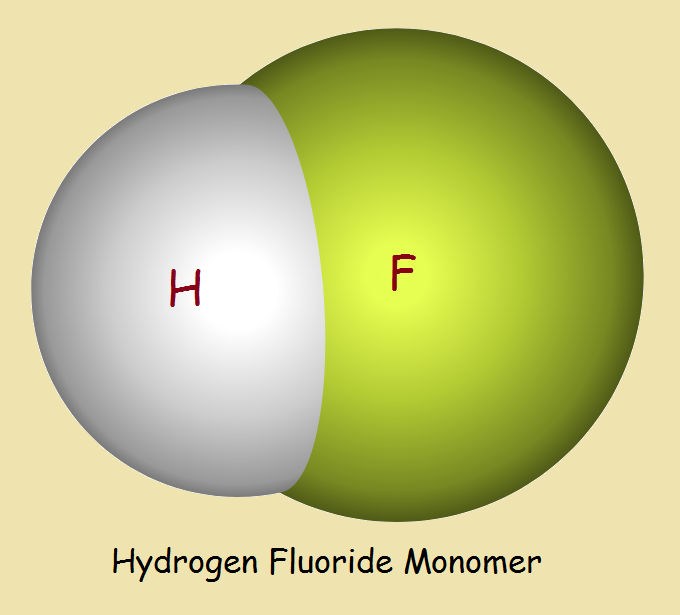 On the far right side of the Periodic Table of the Elements is listed the halogens, which include fluorine, chlorine, bromine, iodine, and astatine. In order of ascending atomic weight we have: fluorine and chlorine gases, bromine liquid, and iodine and astatine solids. Each exhibits a –1 valence. Each attaches to a single atom of hydrogen to form an anhydrous acid.
On the far right side of the Periodic Table of the Elements is listed the halogens, which include fluorine, chlorine, bromine, iodine, and astatine. In order of ascending atomic weight we have: fluorine and chlorine gases, bromine liquid, and iodine and astatine solids. Each exhibits a –1 valence. Each attaches to a single atom of hydrogen to form an anhydrous acid.
Most of these acids are considered very strong with the exception of hydrofluoric acid. It is comparably a relatively weak acid. This is the case, even though hydrofluoric is the only acid stored in polyethylene bottles because it dissolves glass. Since it can eat its way through glass, how can hydrofluoric acid be considered a weak acid?
Hydrofluoric Acid Attacks Glass
While hydrofluoric acid is usually written HF, for the purpose of our discussion we will use H2F2, since its molecules tend to form hydrogen bonded clusters.
Since glass is essentially a modification of silica, we will write the reaction of hydrofluoric acid with glass using in place of glass SiO2. The reaction in the presence of an excess of hydrofluoric acid seems to be at least a two-step process. We write,
- 2 H2F2 + SiO2 → SiF4 + 2 H2O.
- H2F2 + SiF4 → H2SiF6
The products resulting these two steps is finally fluosilicic acid plus water. Doesn’t this attack indicate hydrofluoric acid is really a strong acid? No.
What Makes an Acid Strong?
The halogen acids HCl, HBr, HI, and HAt ionize nearly completely in water. For instance, for hydrochloric acid, one obtains H+ and Cl–ions. The hydrogen ions are quickly join with a molecule of water to form (H30+). It is a high degree of ionization that makes an acid strong. A weak acid ionizes little.
Why Hydrofluoric Acid Ionizes Slightly
It’s a matter of electronegativity¹. Fluorine is the most electronegative of the elements on the periodic table. What is electronegativity? It is a measure of how strongly an atom attracts bonding electrons to itself. What factor makes fluorine so much more electronegative than chlorine? Consider the electron makeup of F and Cl,
- Fluorine Electrons 1s22s22p5
- Chlorine Electrons 1s22s22p63s23p5
When hydrogen combines with fluorine, its electron goes to fluorine’s second level, whereas when hydrogen combines with chlorine, its electron goes to chlorine’s third level. The third level is more distant than the second from the nucleus, thus the hydrogen is held more strongly by fluorine than it is by chlorine.
Since fluorine holds its hydrogen with greater tenacity, ionization is diminished for hydrofluoric acid. Thus H2F2 is considerably weaker than the other halogen acids. So why does hydrofluoric acid dissolve glass the others do not?
Why Hydrofluoric Acid Dissolves Glass
It appears there is an another factor besides acidity alone that enables hydrofluoric acid to dissolve glass. It involves, not just the H+ ion, but the entire H2F2 molecule.
What is the target of attack? Curiously, it appears to be, at least in part, the bridging oxygen atoms. For a discussion of the rather complex mechanism, see the reference posted below.
In Conclusion
Hydrofluoric acid’s strength does not enable it to dissolve glass. If it did, then surely the other halogen acids would dissolve it as well. Rather, a more complex attack is involved, involving at least two steps, with the initial attack involving the oxygen atom, and at least on additional step affecting silicon and the other components that make up the glass.
¹ Electronegativity was first explained by chemist Linus Pauling. See Which are Stronger? Covalent or Ionic Bonds?
Note: You might also enjoy What Makes Ice Slippery Compared to Other Solids?
References:
